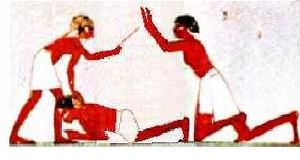Egypt: Difference between revisions
(Created page with "{{WorldMap|EG}} {{header}} '''Egypt''' is a country in Northern Africa. Its population is about 76 million and its official language is Arabic. Its capital and largest cit...") |
m (Text replacement - "cudgel" to "cudgel") |
||
| Line 15: | Line 15: | ||
The [[scourge]], or flail, and the crook, are the two symbols of [[power]] and [[domination]] depicted in the hands of Osiris in Egyptian monuments. They are the unchanging form of the instrument throughout the ages; though, the flail depicted in Egyptian mythology was an agricultural instrument used to thresh wheat, and not for corporal punishment. | The [[scourge]], or flail, and the crook, are the two symbols of [[power]] and [[domination]] depicted in the hands of Osiris in Egyptian monuments. They are the unchanging form of the instrument throughout the ages; though, the flail depicted in Egyptian mythology was an agricultural instrument used to thresh wheat, and not for corporal punishment. | ||
Egypt used [[judicial corporal punishment]] and [[prison corporal punishment]] until recently. Adult men in Egyptian prisons were chastised with a [[whip]] which had a cord on a cudgel branching into seven tails, each with six knots, a variant of the [[cat o' nine tails]]. Boys in Egyptian prisons were subject to corporal punishment too, but they were not whipped but [[caning|caned]]. Women and girls were not subject to judicial or prison corporal punishment in modernity, only males. | Egypt used [[judicial corporal punishment]] and [[prison corporal punishment]] until recently. Adult men in Egyptian prisons were chastised with a [[whip]] which had a cord on a [[cudgel]] branching into seven tails, each with six knots, a variant of the [[cat o' nine tails]]. Boys in Egyptian prisons were subject to corporal punishment too, but they were not whipped but [[caning|caned]]. Women and girls were not subject to judicial or prison corporal punishment in modernity, only males. | ||
In Egypt today, [[school corporal punishment]] is abandoned. Parents may still legally use nonabusive corporal punishment on their children. | In Egypt today, [[school corporal punishment]] is abandoned. Parents may still legally use nonabusive corporal punishment on their children. | ||
Revision as of 15:44, 16 September 2020
Egypt is a country in Northern Africa. Its population is about 76 million and its official language is Arabic. Its capital and largest city is Cairo.
Culturally, we must differenciate Ancient Egypt from modern, Islamic Egypt.
Spanking in Egypt
Ancient Egypt was one of the world's first high cultures and it is not surprising that it was also a culture in which corporal punishment was common. Imagery of that is preserved for example in Beni Hasan.
It can be assumed that if adults were subject to corporal punishment in those days, so were children in the home, at school and at work, albeit in milder forms. However not much is known about that.
The scourge, or flail, and the crook, are the two symbols of power and domination depicted in the hands of Osiris in Egyptian monuments. They are the unchanging form of the instrument throughout the ages; though, the flail depicted in Egyptian mythology was an agricultural instrument used to thresh wheat, and not for corporal punishment.
Egypt used judicial corporal punishment and prison corporal punishment until recently. Adult men in Egyptian prisons were chastised with a whip which had a cord on a cudgel branching into seven tails, each with six knots, a variant of the cat o' nine tails. Boys in Egyptian prisons were subject to corporal punishment too, but they were not whipped but caned. Women and girls were not subject to judicial or prison corporal punishment in modernity, only males.
In Egypt today, school corporal punishment is abandoned. Parents may still legally use nonabusive corporal punishment on their children.
Egyptian spanking artists
The artists of Ancient Egypt are anonymous. There are no contemporary Egyptian spanking artists known so far.
See also
| This page may use content from Wikipedia. The original article was at Egypt. The list of authors can be seen in the page history. |
Chat rooms • What links here • Copyright info • Contact information • Category:Root
